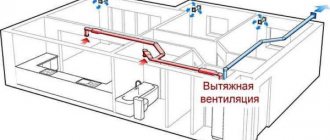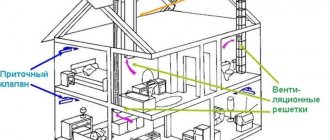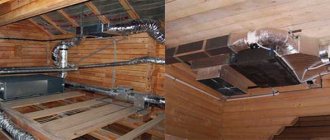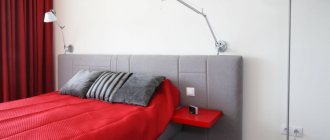The tightness of PVC window systems is both an advantage and a disadvantage. By retaining heat in winter and coolness in summer, such structures prevent the natural circulation of atmospheric masses.
The absence of cracks in the frames that ensure normal air exchange in rooms with wooden products leads to the need to use special devices for ventilation in rooms with plastic windows.
Let's take a closer look at the types of such ventilation systems.
Why is ventilation needed and its types?
In areas where clothes and shoes are stored, it is imperative to organize good air exchange. Skin particles remain on things and shoes, skin secretions remain, and dust accumulates. All this is an excellent environment for the development of microorganisms. Therefore, good ventilation in the dressing room is a prerequisite for maintaining the normal state of things and the absence of a musty smell.
In dressing rooms, as in any other rooms, ventilation can be natural or forced. Natural ventilation works through physical processes - cold air enters from below, heats up and rises to the top. Therefore, if you make a supply hole at the bottom and an exhaust hole at the top, air movement will be ensured at a certain speed.
The principle of organizing ventilation of a house or apartment. Wardrobe ventilation is part of this system
If there are ventilation ducts near the dressing room, it makes sense to make a branch to the exhaust vent. This will solve many problems.
But the natural ventilation of a dressing room cannot always provide a sufficient air exchange rate. To increase it, fans are installed. They can be installed in both supply and exhaust openings. Most often, a forced hood is installed, and air flows naturally through ventilation gaps or holes. This allows you to not spend too much money, but still ensure a normal atmosphere in the room.
Completed projects
Look at all our projects in the portfolio, it's very interesting.
Area - 120 sq. m. Client – Individual
Apartment in “Brilliant House”
Design and installation of ventilation and air conditioning systems
Area - 12,000 sq. m. Client - AAG Group of Companies
Residential complex "House on Frunzenskaya"
Design of the “P” stage of the section “Information about engineering equipment, support networks, list of engineering activities, content of technological solutions”
Area - 9,825 sq.m. Client – “Development Center”
How to check whether a room without a window is ventilated?
Most often, in houses, especially apartment buildings, the developer provides a natural ventilation system. It is designed as follows: air exchange occurs through vertically located channels that run from the roof of the house to the basement. Using special outlets, unventilated areas of apartments are connected to the ventilation system. For many reasons, the ventilation in a room may not work.
In order to check the functionality of the ventilation system, you need to set fire to a rolled-up sheet of newspaper and bring it to the grille. It should be kept at a distance of 2 cm; if the paper is pressed against the grille, then the ventilation is working correctly and nothing interferes with the air circulation. If smoke goes into the room or the sheet is not pressed under the influence of the air flow, then there is no hood.
Tip: When checking how the system functions, do not use open flame. The newsprint should smoke but not burn. An open fire can be dangerous, as combustible and various flammable substances can form in a clogged exhaust pipe.
Stage two: cleaning
We check each vent individually. There is a difference in the deviation of the paper - blockage in the boxes indoors. This is not the worst case: we place the dish brush on a thin flexible steel cable (better) or on an aluminum wire (as a last resort), and screw as far as possible along the way. We remove the remaining debris with a vacuum cleaner with a long tube - a piece of vinyl watering hose works well. It is quite rigid and at the same time flexible.
Did not help? Did you find any garbage? This means that the main ventilation duct is clogged. We clean it the same way, but you need a larger brush. Most likely, you will also need a rod, wooden or metal, or a piece of fiberglass rod, which cable workers use, with a hook.
Warning 2: Be careful when cleaning the main vents! There may be a nest of wasps or a crowd of other dangerous creatures.
standard ventilation scheme in an apartment building
If you live in an apartment building, cleaning the ventilation is the responsibility of the homeowner or the organization entrusted with the operation of the buildings, and you are not allowed to go into the main passage. In this case, you need to make a claim and submit an application.
The role of air circulation systems
Ventilation in a room without windows plays a big role. Even if a room is used infrequently, carbon dioxide accumulates in it. If more than one person is constantly in the room, heat is generated at the rate of 60 W per hour, it creates excess moisture, which, in the absence of natural or artificial ventilation, will settle on the walls. As a result, it will be very stuffy inside, fungus will form on the walls, the spores of which are dangerous to breathe.
Clean ventilation ducts may not always provide the required amount of fresh airflow, even if the room has a window. The fact is that solid plastic products reliably insulate the room. There are positive aspects to this, but there are also disadvantages, for example, the room does not ventilate itself. With the help of special equipment, the problem can be solved: the system will forcefully ventilate the room.
Window fittings
Metal parts will ensure the window opens in different planes
When assembling a window, metal parts are installed in a groove on the profile, which provide various opening positions and clamping of the sash in the closed position. A micro-ventilation mechanism can be included in this system. Ideally, it is installed immediately at the time of assembly at the factory.
But if the window was installed a long time ago, it is quite possible to install the mechanism on site. To do this, you should contact specialists. Any company engaged in the repair of metal-plastic structures provides this service.
The mechanism fixes the gap between the sash and the frame, sufficient for air flow (no more than 3 mm). It usually opens by turning the handle 45 degrees. There are multi-stage locking mechanisms (handle rotation by 15, 45 and 60 degrees).
Arrangement of forced ventilation
Knowing how to make ventilation in a room without windows or with solid structures, you can do the work yourself. To do this, you will need two fans with approximately the same power. In addition, you will need to purchase a heater and filter; One device will be enough to operate the system.
In order to have somewhere to get air from, ventilation channels are punched in the walls. Pipes will be inserted there: to make holes for them, you will need to use a hammer drill.
Air exchange requirements for rooms without windows
According to documents SP 60.13330.2012 and SP 54.13330.2016, for a residential space with an area of less than 20 m2, regardless of the number of people, the required air exchange is 3 m3/h per 1 m2 of area. Thus, full ventilation in a dressing room with an area of 8 m2 requires an air exchange of 24 m3/h.
For the bathroom, the standards are somewhat different. Regular air exchange should be 25 m3/h for separate and combined bathrooms and toilets.
If a closed room is a bedroom or other room in which people are constantly and the area of which is more than 20 m2, there must be at least 30 cubic meters of air per person per hour.
Ventilation in a windowless room in an apartment is possible using two methods:
- If the room has an external wall, then fresh air is supplied directly from the street.
- If not a single wall of the room faces the street, then the flow of air into the room without a window must be organized through another room with good ventilation.
Ventilation of a blind room without a window with an external wall
The easiest way to organize a flow of fresh air is with the help of supply devices - a wall valve or a breather.
Wall valves generally have low performance and are only suitable for small spaces. The breather organizes air supply for five people. Its three filters purify dirty air from dust, allergens and harmful gases. The Breezer is compatible with the MagicAir smart microclimate system, so it is convenient to control it from a smartphone.
The exhaust air will tend to another room where there is exhaust ventilation, for example, a bathroom.
Prices
A budget Breezer, designed for 32 m2 , costs 21,000 rubles . Model with a capacity of up to 140 m3/hour – 43,000 rub.
A supply wall valve will cost much less - the cost ranges from 1000 rubles. for a simple device, up to 8500 rub. for a model with a turbine and a high-quality filtration system.
The cost of a valve mounted on a window without milling is from 350 rubles. Overhead modifications that require complex installation - up to 4,500 rubles.
Ventilation in a blind room without an external wall
Leaving the door to the room open to allow fresh air from another room to enter is the simplest solution, but not always ideal. For example, if a windowless room serves as a workshop, you will need to lock the door to protect children and pets from fragile parts or dangerous tools. In such a situation, doors with bars at the bottom or ventilation holes in the wall will help.
If it is not possible to organize ventilation of each room, then the volume of air entering the ventilated rooms should be sufficient for the volume of all rooms.
When ventilation is organized during the process of redevelopment or repair, one of the walls of the room without windows is not completed, that is, 10–20 cm are left between the top point of the wall and the ceiling. The air movement to the hood will be directed through this hole.
If your home has a ventilation system, you can try running a separate line of ducts to the room. This option is more relevant for those premises in which finishing work is still underway; otherwise, laying additional air ducts in the ventilation system may ruin the repair.
Ventilation in a blind bedroom without a window
Ventilation in a bedroom without a window requires a particularly careful approach: the air quality determines how easily you will wake up in the morning. In just an hour, two people in a bedroom manage to “inhale” a level of carbon dioxide that is three times higher than the norm! It is precisely because of the high concentration of CO2 that in the morning we are overcome by a feeling of weakness and lack of sleep.
In this case, natural ventilation in a room without windows is unlikely to provide the necessary air exchange - we recommend using a breather so that there is always enough fresh air. The CO2 sensor of the MagicAir monitoring system will help you track the level of carbon dioxide in the room.
How much air do you need to provide?
It is important to calculate the required volume of air masses required for the room. In calculations you need to rely on the following nuances:
- how many people and how often will be in such a room;
- what exactly will the room be used for (if for relaxation and quiet time, then you can get by with an influx of 30 m³/h per person, if complex physical work is performed, then 60);
- what conditions are typical for the room (for example, if it is a basement, then the likelihood of dampness inside is higher than in an above-ground room);
- whether harmful hazardous substances will be released (for example, if a workshop is being built in a windowless room where painting work will be carried out).
For most cases, a simple calculation can be done. It follows from this that about 30 cubic meters of air per hour are required per person in the room. This is the minimum value, but in general it is advisable to raise it to 32-35 cubic meters of air per hour.
How to make ventilation in a dressing room without windows
Mostly, dressing rooms are located in small rooms without windows. In this case, there is no hope for air flow through the cracks. We need to make holes. Inflow can be provided through:
- gap between the bottom edge of the door and the floor;
- special door design for dressing rooms (with slots or inserted ventilation grilles);
- holes in the walls, which are located at a height of no more than 20-30 cm from the floor (possibly lower, just above the baseboards);
- technological gaps left during the construction of partitions;
- in private houses - through a ventilation hole in the floor (from the lower floor or from the basement, if there is normal humidity there).
There are adjustable grilles
The dimensions of the supply openings depend on the volume of the room and the speed of movement of air masses. According to the standards in dressing rooms for storing things, it is necessary to ensure a one-time air exchange. For example, what if your dressing room has dimensions of 1.5 * 2.0 * 2.8 (width, length, height), then its volume (found by multiplying all numbers) is 8.4 cubic meters. In an hour, to maintain normal air, 8.4 cubic meters of air. This way, dressing room ventilation will prevent the appearance of foreign odors.
If ventilation works normally in the apartment, for these purposes it is enough to make an inlet opening measuring 100*100 mm. Section - round, square, rectangular - it doesn't matter. The main thing is that its area remains the same or more. In general, this parameter is calculated or found from a table. But the tables indicate much larger volumes.
Table of dependence of air exchange on the size of ventilation ducts and exchange rate
But the ventilation of the dressing room will work normally provided that there is an exhaust duct. This could be a similar lattice in the wall. It should be located on the wall opposite the supply hole, closer to the ceiling. Moreover, we must strive to space these holes as far as possible - so that the air flow covers as large an area as possible.
If the supply opening is made in the door, and the doors are in the middle of the width of the room, then it is worth installing two exhaust grilles - on the right and on the left, 15-25 cm away from the corners.
Where should the exhaust vents go? At best - into the ventilation duct. A possible option is to go outside, if one or more walls of the dressing room face the street. In this case, you can take the supply duct to the street, and the exhaust duct to the ventilation or any of the adjacent rooms.
How to do it?
In many ways, the solution to this problem depends on whether this room borders the street or not. If it borders, then it will be much easier to install a ventilation system, and this will not require the installation of air ducts. If it does not border, then the task becomes more complicated, and will depend on how far the room is from the street.
Another main rule: in “dirty” rooms an exhaust hood is always installed, and in “clean” rooms a supply air supply is installed. “Dirty” includes the kitchen, bathrooms, and rooms where harmful substances are released into the air.
Below we will look at some of the simplest situations and methods for solving them.
If it's a kitchen
A prerequisite for organizing a ventilation system is the presence of a ventilation shaft in it. It will act as an exhaust system and stale air will be removed through it. The second option is to exhaust air through a kitchen hood (which is vented either into the ventilation shaft or directly outside, through a wall or through an air duct).
The air flow will be carried out from other rooms: either through the cracks under the doors, or through the transfer grilles (if there are no cracks).
In this case, it is necessary to check the draft of the ventilation shaft. To do this, you need to take a strip of thin paper and bring it to the ventilation grill.
If the piece of paper is attracted, the ventilation shaft is working normally. If not, or attracts very weakly, the ventilation shaft either does not work at all or works poorly (possibly due to the fact that it is clogged and needs to be cleaned). If for some reason cleaning is not possible now, it makes sense to install a forced exhaust fan in the wall, with output directly to the street.
The power of the fan must completely ensure the removal of air in a volume equal to the number of people living, multiplied by 30. For example, if 3 people live in an apartment, then the fan must remove at least 90 cubic meters of air per hour.
If this is a room that borders the street through at least 1 wall
If this is a “dirty” room, then a hole is made in the street wall and a fan is inserted into it. It will draw air out, and the influx will come from other rooms (through transfer grilles or through cracks under the doors).
Arrangement of fresh air ventilation in the apartment
If this is a “clean” room, then an inflow is made through the street wall using any of the methods below:
- through the supply wall valve;
- through the air handling unit;
- through the hole with the installed fan.
Air removal will be carried out through another room from which the hood is made.
If this is a room that does not border the street
Often in such cases we are talking about a storage room (if it is an apartment or a house), which is often located in the “depths” of the home.
In this case, you can arrange the ventilation system in one of the following ways:
- If a room without windows is located between another room where there is an inflow, and another room in which there is an exhaust hood. You can make holes in the walls between them by covering them with bars (or installing a fan in one or both holes). This option is suitable if you need little air (if the room is small), and if clean air will come from the room from which there will be inflow.
- If the building (apartment, house) has an air duct system (either supply or exhaust, or one or the other). In this case, a separate line of air ducts is laid to a room without windows. If the ventilation duct serves only one purpose (for example, it only removes air), then the inflow also needs to be arranged separately. This can be done, for example, from the next room, through a hole.
- If the room is too large, or the exhaust/ventilation shaft opening is far away, it would be better to lay an air duct for both supply and exhaust. Moreover, in this case it is necessary to install a fan on both systems.
Installation of ventilation in a room without windows (video)
If the room is located below ground level
We are talking about the basement. If at least a small part of the room is above ground level, an inflow can be made through the wall in this place. The exhaust is done through the building's exhaust system (ventilation shaft or simply an exhaust hood). If there is no ventilation shaft, then air is removed through a hole (with or without a fan) in the wall, which is opposite the inflow point.
If the room is located completely below ground level, in this case both supply and exhaust are organized through air ducts with fans. Pipes are laid from the surface, through the walls, opposite each other (supply on one wall, exhaust on the other). Fans are inserted into the pipes: one supplies air inside, the second blows it outside.
Video description
An example of combining natural ventilation with a hood in the kitchen in the video:
Since a kitchen stove is a constant source of fairly strong odors, the area above the stove needs ventilation most of all, and it is above it that the natural ventilation outlet channel or an electromechanical hood is placed.
When installing ventilation in the gas stove area, first of all, it is necessary to compare the number of burners with the volume of kitchen air space. The standards require:
- for a kitchen space with a volume of more than 8 m³, it is allowed to install a stove with two burners;
- for a kitchen with a volume of 12 cubic meters - no more than three burners;
- for a kitchen of 15 cubic meters - 4 burners.
If this standard is observed, for high-quality air exchange in the kitchen with a gas stove, an air exchange rate of 140 m³/hour is sufficient, and with an electric stove – 110 m³/hour.
Bath ventilation
The air in the bathhouse has its own specific specifics - during bathing procedures the humidity reaches 100%, and when the bathhouse is not in use, everything depends on the quality of air exchange in the room. To comprehensively solve these issues, mixed ventilation is used.
An example of air movement in a bath Source elektroservis-rostov.ru
But since the mechanical part is needed only during the operation of the bathhouse, then, in fact, the most effective natural ventilation is made and fans are added to it. Thus, during operation, the power of the ventilated installation allows you to comfortably steam in the bathhouse, and during its downtime, natural ventilation ventilates the room.
Technically, this is expressed in the arrangement of one or two supply channels and an outlet on which a fan is installed (preferably with an adjustable number of blade revolutions).
It is important! When arranging a bathhouse, one should not forget about floor ventilation. To do this, the floor covering is assembled from boards with a gap of 5 mm between them.
Natural ventilation in a dark room
If the layout of the apartment was initially designed in such a way that there are rooms without windows, then the walls must have ventilation ducts for natural ventilation, which look like small holes in the wall under the ceiling, covered with bars.
If there are no such holes in the wall or the draft is disrupted, then the air in the room becomes stuffy. Natural ventilation in such rooms can be easily improved by installing a fan on the air duct opening or by installing special forced-type air supply devices if there are no air ducts in the wall.
The movement of air masses can also be improved by cross-ventilating the entire apartment. But through ventilation during the cold period is fraught with the formation of condensation on windows and walls.
Do-it-yourself supply ventilation in a dead room
Sometimes the natural ventilation of an apartment is not enough to ensure normal air exchange in all rooms, especially where there are no windows. Therefore, for a normal microclimate in rooms without windows, forced ventilation is used.
In a room without windows, forced-air ventilation is most often installed.
The supply ventilation system consists of a hole in the wall and a valve with a plug. Sometimes the supply ventilation in the bedroom is additionally equipped with fans, heaters and filters for air purification.
Most people do not know how to make ventilation in a room without windows with their own hands, but installing ventilation does not require special knowledge or effort. To organize ventilation you will need:
- A device for making large-diameter holes in a wall or a hammer drill with a special attachment.
- A piece of plastic pipe of suitable diameter.
- Plug and mesh.
- Insulation.
A hole is made in the wall into which insulation is placed. A piece of plastic pipe of suitable diameter is inserted into the hole on top of the insulation. The voids between the insulation and the pipe are filled with polyurethane foam.
On the street side, the pipe is covered with a mesh to prevent street debris from entering the valve. In the room, the hole is closed with a specialized plug with the ability to regulate the air flow.
In a room without windows, this type of ventilation helps to provide a comfortable microclimate, but in winter it will require additional costs to heat the room.
If the owner wants to save on heating the room in winter, he should purchase a ready-made structure that allows the room to be ventilated at any time of the year without additional energy costs. Such ready-made structures can also be installed independently.
Valve Installation Options
Installation of an overhead valve on a metal-plastic window block is carried out as follows:
- Remove the sash;
- Using a pencil and a ruler, mark the location of the future drilling (approximately in the middle, at the same level, in accordance with the dimensions of the valve);
- Using a drill of a suitable diameter, we drill according to the markings, after which we connect the holes by sawing with a nail file (it is much more convenient to use a hand-held milling machine, but unlike a drill, not everyone has one);
- Guided by the instructions supplied with the filter, we mount its elements;
- We put the sash in place.
More details can be seen in the video:
Installing a wall supply valve in a number of situations requires special equipment. This primarily applies to the installation of large-diameter valves in thick walls. To make a hole you will need a powerful hammer drill and a drill of the appropriate diameter and length.
Such a tool is rare in the household. In addition, difficulties may arise when working on upper floors. Otherwise, installing a wall valve does not require any professional skills and is carried out according to the attached manual.
For the process of installing such valves in an apartment, watch our video:
Subscribe
Ready-made solutions for your home
To simplify the ventilation of rooms without windows, forced ventilation devices were invented. Such devices are called aerogivers; they are easily mounted on a wall inside a room. Although air vents are expensive and can only provide fresh air in the room where they are installed, they are an excellent ready-made solution for organizing air exchange.
A good ready-made solution for apartments and houses with blind rooms is split systems with climate control.
Aerogivers
Aerogivers consist of devices that allow the flow of clean air into the room; filters to clean the air from dust, harmful impurities, and allergens; recuperators and dryers.
It is easy to install the airgiver in an apartment yourself; to do this, you will need to carefully study the instructions and prepare the device for making a hole in the wall.
The main advantage of such devices: the room is ventilated around the clock, but there are no unpleasant odors from the street in the room. Clean air enters the room already heated, because... Most of these devices are equipped with a recuperator.
When installed correctly, aerogivers do not create additional noise in the room, so they can be installed even in a nursery.
Air conditioner
Almost all modern air conditioners are made in such a way that they provide a flow of fresh air into the apartment from the street, and do not simply dehumidify the air inside the room. Therefore, split systems with climate control are a complete replacement for natural ventilation in rooms without windows.
Some air conditioners can additionally enrich the air with ions, warm it up and clean it of allergens.
But split systems with climate control capabilities are installed point-by-point and are not able to ensure the correct movement of air masses throughout the apartment. Therefore, to ensure a comfortable microclimate throughout the apartment, it will be necessary to install air conditioners in each room.
Tips, recommendations, nuances
Often, owners of private houses are lenient when it comes to ventilation requirements for their own home, especially if they may entail additional costs. Here are some misconceptions regarding the use of technical means in residential premises.
- Installing an air conditioner will solve all ventilation problems.
The air conditioner is able to change air parameters, cool or heat the air, and dry it. But it does not create an air cycle. In a house with a working air conditioner, a comfortable temperature will be established, but after a couple of hours the body will feel a lack of oxygen and an excess of carbon dioxide.
Ventilation is always installed along with air conditioners Source anantaircon.podbean.com
- If you install an exhaust fan, this will be enough for good ventilation of the house..
If plastic sealed double-glazed windows and doors are installed, there is no air flow, which means there will be no exhaust/removal of air masses. After a few minutes of operation of the hood, a pressure will be established in the room that simply will not push air to the fan blades.
- Periodic ventilation or an open window for micro-ventilation will solve all problems.
The issue of ventilation will not be fully resolved, since there remain fairly large periods of time during which it will not be possible to ventilate the house, for example, at night. If in the summer this is a solvable issue, then micro-ventilation in the winter is fraught with drafts that will quickly cool the room, preventing it from being ventilated.
- Using equipment with a heater will allow it to be operated at the lowest temperatures
As a rule, equipment with recovery has restrictions on the minimum outdoor air temperature. This is due to the capabilities of the recuperator and the limit is -25…-30 oC. If the temperature drops, the condensate from the exhaust air will freeze on the recuperator, so at ultra-low temperatures an electric preheater or a water preheater with antifreeze liquid is used. (The range of these installations is presented on our website)
Schemes of ventilation systems for dressing rooms of different layouts
In addition to volume, the main parameter when choosing a scheme is the layout and location of the wardrobe in the apartment. Further actions depend on where exactly it is located and what rooms it borders on.
The options are:
- A wardrobe (essentially a partition from floor to ceiling that delimits a room).
- Separate room with window.
- A separate room without a window, through the wall (at least one) - the street.
- A separate room, surrounded by other rooms (no window or outside wall). The option is the most inconvenient in terms of ventilation, but the most common - in apartment buildings, utility rooms are usually planned this way.
Below we will look at how to make a ventilation system for each case.
Closet
This option is common in both apartments and houses - instead of installing ordinary wardrobes and/or chests of drawers.
The air exchange device depends on how many walls (partitions) the wardrobe has and what size it is. Typically, such wardrobes are not made huge: most often it is a “simple” wardrobe with shelves and drawers, just not free-standing, but “attached” to the wall.
Let's consider how to organize its ventilation depending on different layouts:
- If the closet has only one - front - partition, and on the other 3 sides there are apartment walls bordering the living rooms. It will be enough to embed the transfer grilles in the lower and upper parts of the partition.
- If the closet has only a front partition, the remaining 3 sides have apartment walls, one of which borders the bathroom/kitchen. In this case, you can embed a transfer grille into the lower part of the partition (through it there will be an air flow from the room to the closet). To remove air, you can drill a hole in the wall between the cabinet and the kitchen/bathroom and cover it with a grill. The option is not the most convenient: perhaps in the future you will want to rearrange and move the cabinet, and in this place there will be a hole in the wall.
- If the cabinet has 2 or more partitions. In this case, a flow grille is embedded from below into the partition, which is located closer to the window. The second transfer grille cuts into the top (closer to the ceiling) in the partition, which is located closer to the door.
In general, it is not necessary to bother with ventilation in wardrobes - in most cases, it is enough to simply cut the flow grilles into the door, and that will be enough.
Separate room with window
The simplest option, in which you can do nothing at all: all the conditions have already been created.
Dressing room with 2 windows
In this case, air flow can be ensured in the following ways:
- Keep the window slightly open. Suitable if the window sash is fixed in several positions, and if there is no source of loud noise or odors under your window.
- Install the window comb and keep the window slightly open. Suitable if the window sash does not have “its own” fixation modes. Cost: the simplest comb can cost up to 1000 rubles.
- Install windows with micro-ventilation mode (if the apartment is under renovation, or it’s time to change the windows). This option is better than the previous ones in that you don’t have to keep the window open. This means that street sounds and smells will not enter it, insects will not fly in, rain or snow will not fall into it.
- Install the window valve. Suitable if it is not possible to keep the window open (for example, due to noise), and it does not have a ventilation mode. The downside is that not everyone can install the valve with their own hands. The product itself will cost about 3-5 thousand (depending on the model), installation by specialists can cost about the same.
- Install a window fan. If your dressing room is large, or some expensive items will be stored there, then this option can be considered. Natural ventilation (all the methods above refer to it) has unstable performance, while a fan can maintain constant air exchange.
For the flow and further removal of air, there must be a gap under the door to the wardrobe. If it is not there, then you can embed a transfer grille (or a valve, like Domvent) into the door leaf.
A more expensive and somewhat unusual option: you can install a miniature Aeromat installation in the window. Inside the rectangular housing there are fans that supply air to both the supply and exhaust. That is, they can renew the air even in a sealed room. The downside is that such products cost several tens of thousands of rubles, and only a specialist can install them.
Separate room without window, street through the wall
It will be more difficult to independently organize a ventilation system in such a room than if there was a window. But there are many implementation options.
An example of a ventilation system for such a layout: 1 - air flow through the gap under the door; 2 - place for inserting an exhaust fan
In the previous paragraph, we considered a scheme in which air only enters the dressing room from the street - since in a room with a window this option is the simplest. If there is no window, then in any case you will have to make a hole in the wall for ventilation. And through it it is already possible to organize both inflow and exhaust.
First, let's look at how the air flow through the wall is done. To do this, a hole is drilled in it and a wall valve is inserted. The option is the simplest and cheapest (the valve itself can be purchased for 3-5 thousand, installation will cost the same amount).
There is another option, but it is impractical: instead of a valve, an air supply unit is installed. This device is more expensive: such equipment will cost more than 10 thousand rubles. The most important thing: the units have high air output - which is not necessary for a small dressing room.
As mentioned above, instead of an influx from the wardrobe, you can organize an exhaust hood. In this case, a hole is drilled in the wall and an exhaust fan is inserted into it (which will not blow into the room, but into the street). This option is suitable if the room with a dressing room is located far from the kitchen/bathroom.
The general rule for any method: there must be a flow of air between the wardrobe and the corridor (or room). To do this, either there must be a gap under the door, or there must be a transfer grille in the door leaf.
Separate room, surrounded by other rooms
The most inconvenient and difficult option to implement. Such layouts are common: owners often make wardrobes in closets, which are located “inside” the apartments. And when building houses with dressing rooms, they are also usually located exactly according to this plan.
An example of a ventilation system for such a layout (laying air ducts from the dressing room to the ventilation shaft in the bathroom)
In this case, it will be more difficult to complete the task, especially on your own (without specialists). There are several solution schemes:
- In the wall that borders the living room with a window, if the room is further from the kitchen/bathroom than the wardrobe, a hole is made and covered with a grill. Air will flow through it. The air is removed through the gap under the door into the corridor and then to the nearest ventilation shaft or exhaust hood. If there is no gap, a transfer grille is installed in the door.
- If there is a kitchen/bathroom or a room with a hood across the wall with the wardrobe, a hole is made in this wall and covered with a grill. Air will be removed through it. Fresh - will enter through the gap under the door/transfer grille.
- If the house/apartment is under renovation and suspended ceilings will be installed, you can install a system of air ducts that will remove air from each room. In this case, a separate line is drawn to the wardrobe. The influx of fresh air will come through the gap under the door. The exhaust line can go either to the nearest ventilation shaft (as in the image above), or through the wall to the street (in this case, an exhaust fan is placed in the air duct).
Sources
- https://stroychik.ru/garderobnaja/osveshhenie-i-ventilyaciya
- https://sdelalremont.ru/sposoby-ustrojstva-ventilyacii-v-komnate-bez-okon.html
- https://tion.ru/ventilyaciya/v-komnate-bez-okon/
- https://climatdoma.net/ventilyatsiya-dlya/nezhilyh/ventilyaciya-v-komnate-bez-okon.html
- https://vozduhstroy.ru/ventilyaciya/v-komnate-bez-okon.html
- https://ventihome.ru/dlya/nezhilyh/ventilyaciya-v-garderobnoy-komnate.html
[collapse]
Condensation on the surface of the window glass
From time to time, despite all the tricks aimed at reducing the level of humidity in the room, condensation still appears on the window glass. Many people use various folk remedies to combat it, wipe the windows with dry napkins and rags, and additionally ventilate the room afterward.
Only ventilation grilles for window sills will help you cope with the emerging situation once and for all. Only they will keep the window profile dry, thereby extending its service life for a long time.
Types of devices
A grill installed in the window sill more effectively distributes the flow of warm air near the window, preventing the accumulation of liquid on the glass.
There are many varieties of these devices:
- external, internal and transfer;
- unregulated, adjustable and inertial.
In addition, depending on the type of materials used, gratings are divided into:
- polymer - one of the most common materials, which over time can turn yellow and warp from exposure to high temperatures;
- aluminum - have a good light weight and appearance, the disadvantage is a high price;
- made of wood - goes well with any type of room design, but requires care and special attention;
- metal - have enormous weight, price and attractive appearance.
Installing gratings on a window sill
To independently install devices that help eliminate condensation from the surface of window glass and frame, you need to stock up on the following tools:
- drill;
- marker;
- jigsaw;
- glue for joining polymers;
- weight to secure the grille during installation.
The sequence of actions for installing the grille on the window sill is as follows:
- A pre-purchased device is applied to the window sill, which is outlined along the contour with a pencil or marker.
- Holes are made in the corners of the resulting figure using a drill. Their diameter should be slightly larger than the width of the jigsaw blade.
- After this, a part of the window sill is cut out along the drawn lines. In the future, the place of the removed part will be taken by a decorative grille, providing free access to heated air.
- Then gluing is done. Excess adhesive must be immediately removed with cotton or linen cloth. Once the glue has hardened, this will be problematic.
- Before complete polymerization, a weight must be placed on the attached ventilation grille.











